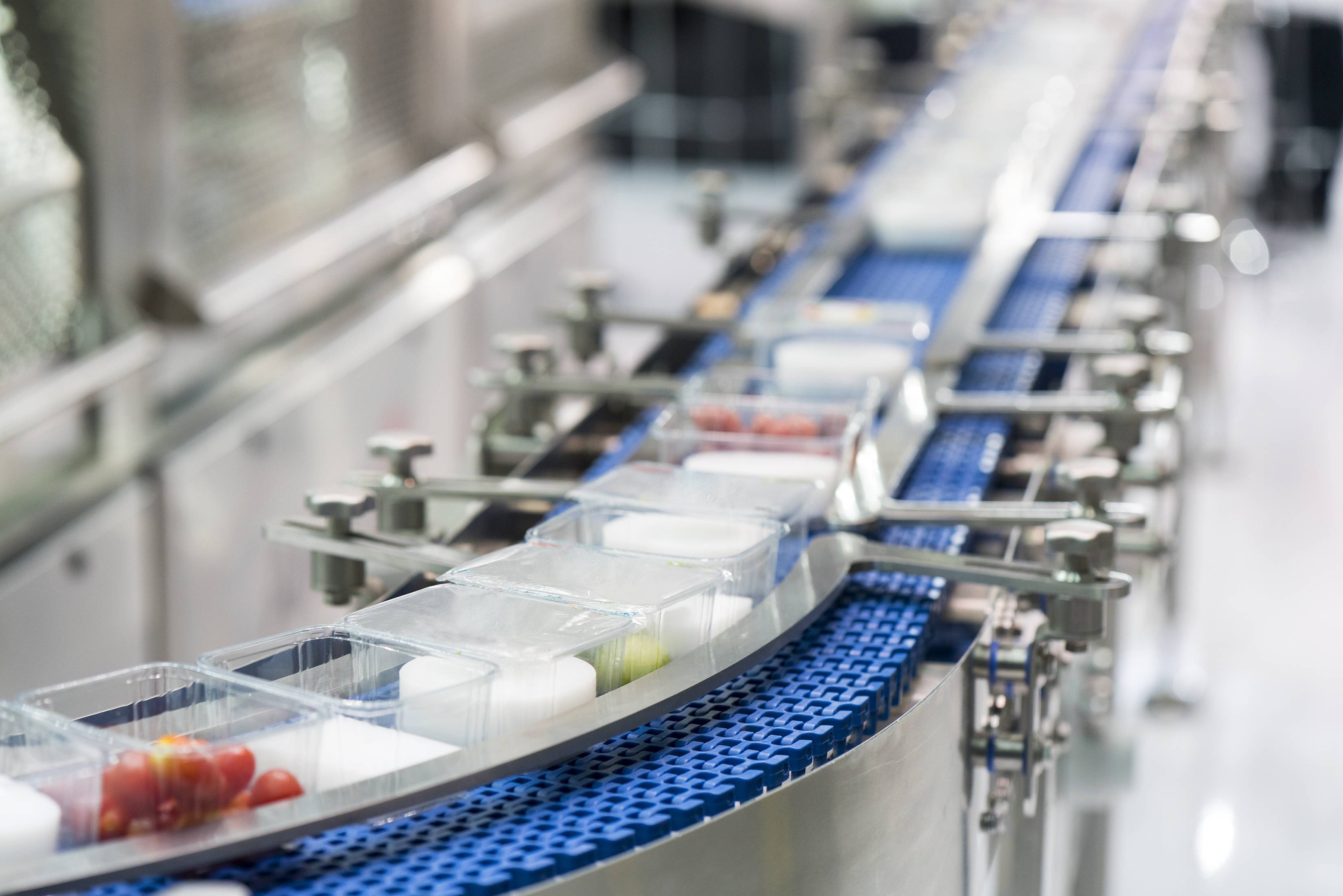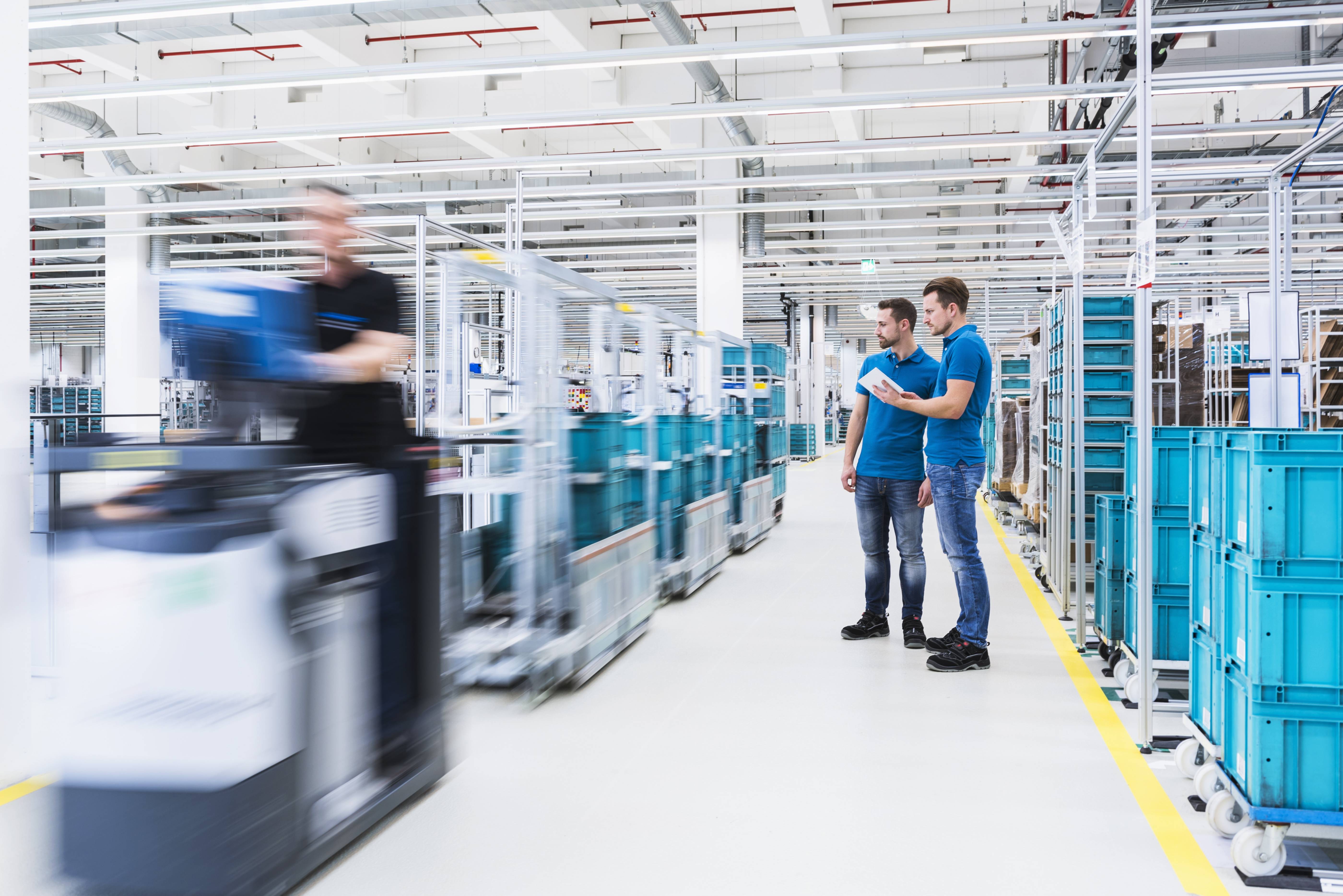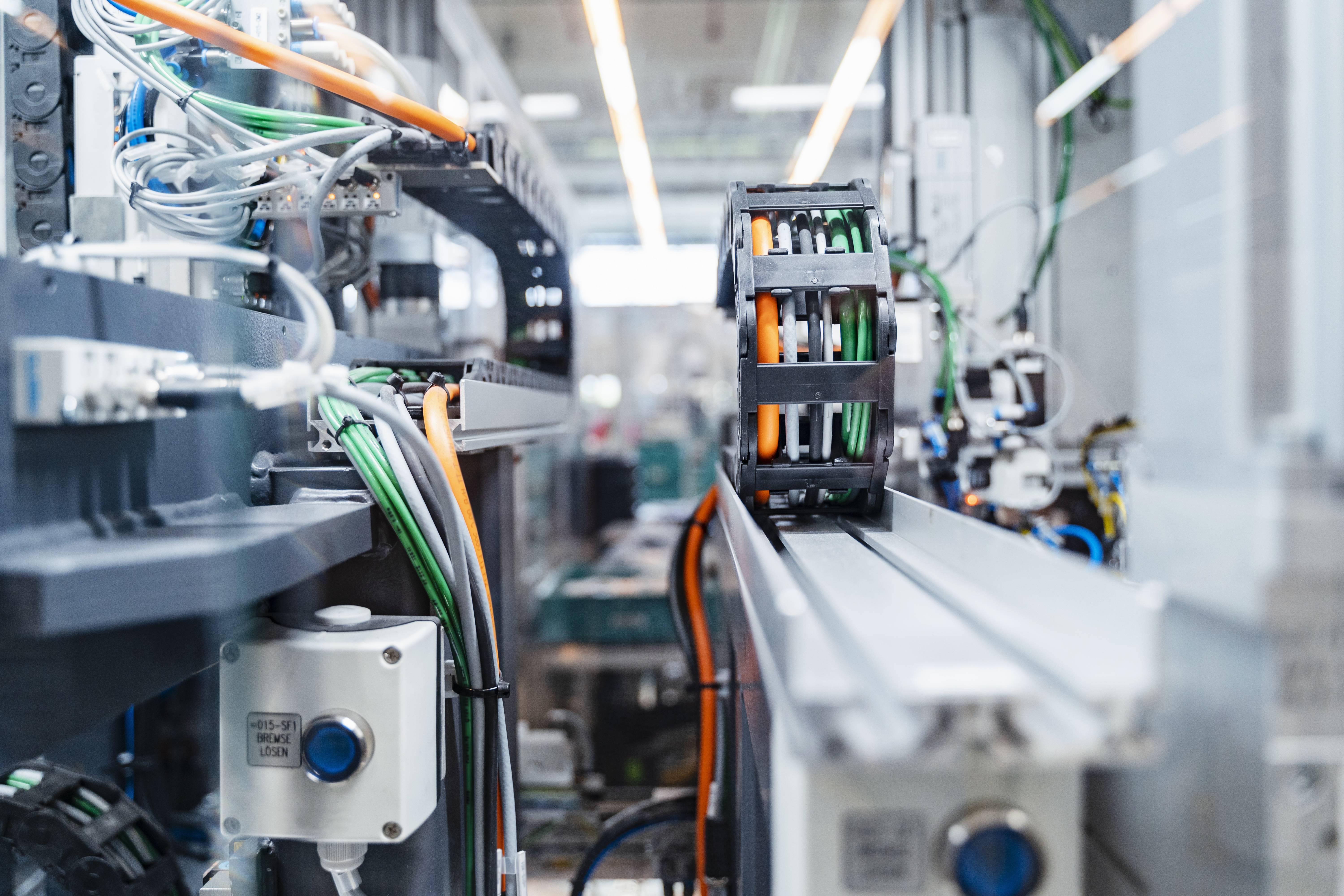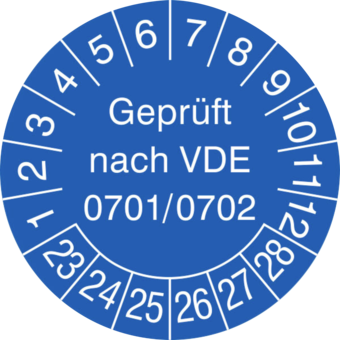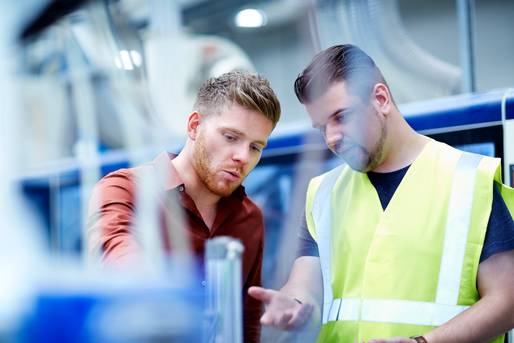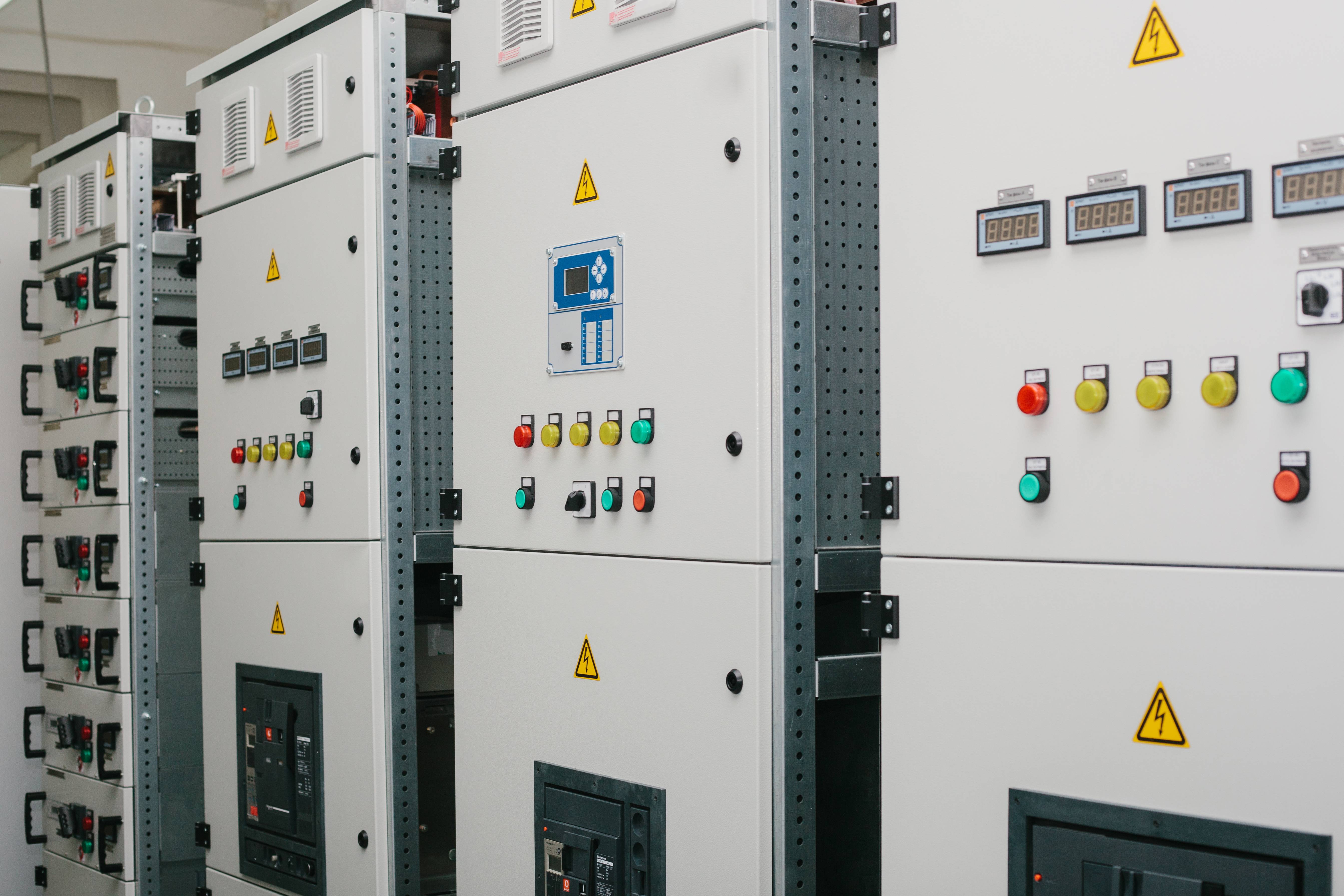Plant engineering & technical installations » Definition & explanation
This text is machine translated.
Updated: 27.10.2023 | Reading time: 7 minutes
What do a computer-aided automatic band saw for the timber industry, a conveyor system for food packaging and a tube-in-tube heat exchanger for biogas production have in common? All three examples are individual technical systems for the realization of complex tasks.
Plants like these are realized in mechanical engineering by plant manufacturers with the necessary know-how. Whether in the food industry, pharmaceutical sector, construction sector, aviation, environmental technology, plastics processing, printing, packaging, building materials industry or automotive industry, there are plant manufacturers for every industry that uses machines and systems.
Companies in the field of plant engineering and conveyor technology develop new systems and manufacture machines according to customer requirements. They also adapt and modernize existing systems and take care of their maintenance over the entire service life of the machines. The maintenance of systems is an important point here, as a customized service should ensure a high level of system availability.
-
Construction - these are the maintenance strategies
Mechanical engineers are generally responsible for all phases in the life cycle of their systems. The work begins with the idea for a system, through planning, development, production, assembly, commissioning and maintenance, right up to recycling. It therefore does not end when the plant is handed over to the customer, but only when it is decommissioned.
An important aspect in the construction and maintenance of technical systems is compliance with all relevant quality standards. Certification in accordance with DIN EN ISO 9001, for example, guarantees plant operators flawless processes and on-time results. The quality and quality of the technical components and parts used in the implementation of the respective design and used during maintenance are decisive for the quality of the systems.
Programmable logic controllers, also known as PLCs at , played a major role in this impressive and rapid development.
Originally, PLC systems were used to replace programmable logic controllers (PLCs), i.e. complex wired systems with countless relays, timing relays, auxiliary contactors and logic modules. This not only completely eliminated the disadvantages of the old control systems, such as high space and material requirements, heavy wear and tear and a lack of flexibility.
Monitoring, maintenance and troubleshooting in the event of a fault are also much easier to carry out with a programmable logic controller.
However, the biggest advantage of modern PLC-controlled systems is the possibility of cross-system networking.
Networked systems and the use of artificial intelligence are aimed at greater automation with self-organized processes. Machine learning helps systems to evaluate large amounts of data and establish correlations in real time. Networked plant processes offer significant added value for the industry, as they make production even more flexible and customizable.
Climate measures and energy efficiency are further important points when constructing and modernizing plants. The economical use of natural resources and energy savings help to meet climate targets, help to protect the environment and are an economic factor against the backdrop of rising energy prices.
Wear, tear, material fatigue, ageing, corrosion, decreasing precision and damage due to external influences or incorrect use can lead to defective components in technical systems. The consequences are reduced performance, restricted use or even downtime. This is why mechanical systems, just like any other complex device, require regular servicing. The main focus here is on maintenance in accordance with DIN 31051, which defines maintenance as maintenance, inspection, repair, improvement and weak point analysis. The aim of these five basic measures is to maintain the target condition of the equipment and restore it if necessary. In addition, the German Ordinance on Industrial Safety and Health (BetrSichV) requires employers to carry out maintenance measures on their systems.
Important:
A consistent maintenance cycle ensures a long service life for the systems. It minimizes downtimes, improves the safety of employees and the environment, keeps costs low and allows the plant operator to create full value.
Construction- these are the maintenance strategies
Maintenance is the umbrella term for all measures that keep systems functioning as fully as possible. Maintenance is divided into the preventive work steps of inspection and servicing and the restorative work step of repair. What exactly are the differences?
Inspection
As part of an inspection, a system technician carries out a functional check. This allows performance losses to be detected at an early stage. The motto of a system inspection is "Look, touch and measure, but don't work on or change anything".
Service employees assess and document the actual condition of the machine and identify deviations from the target condition. To do this, they check the functionality of all assemblies, look at the settings and the output, and usually also carry out measurements. They determine and evaluate the extent and causes of wear and tear. From this, the technicians derive the consequences for future use and for any necessary repairs. The resulting inspection report states which measures are sensible and necessary to restore the system to its target condition. If everything is in order, the system receives an inspection sticker or an inspection certificate. It indicates the proper condition of the system and provides information on the date of the last inspection and the next inspection date.
Maintenance
Predictive maintenance is a recurring preventive measure designed to delay or, in the best case, prevent progressive wear and tear. It protects your capital goods from unplanned breakdowns. Maintenance measures are carried out routinely and at regular intervals. The aim is to restore the target condition and functional reliability of the system for a longer period of time.
Maintenance includes
- Cleaning the relevant system parts
- Replacing worn parts
- Refilling or replacing operating fluids such as lubricants or coolants
- Adjusting or calibrating the system
This maintenance work is followed by a test run as a functional check before the system is released for use again.
Maintenance measures are carried out according to the system manufacturer's specifications at the discretion of the system operator or on the basis of legal or official regulations.
The performance of maintenance work should be recorded. The log serves as proof, for example to the authorities or when enforcing warranty claims against the system manufacturer.
A complete maintenance record also improves the resale value.
Repair
If a defective system component is discovered during maintenance or inspection, the system must be repaired.
The purpose of repairing technical components is to restore the original function and thus the target condition of the system.
Depending on the condition, the components concerned can be repaired or replaced.
The repair measures carried out are documented in the system log.
Increasing the efficiency of plant maintenance
If you want to remain competitive both nationally and internationally, you need to have process engineering and production costs under control. By optimizing production, both the performance and productivity of the company can be continuously increased. Safe operating processes with reliable systems are the basic prerequisite for this. Conrad supports you in plant construction or plant operation with efficient parts solutions for maintenance, inspection and repair. As an industry partner with around 100 years of experience and a wide range of products and brands, we know exactly what is important when it comes to procuring spare parts.
As an authorized single-source supplier, we offer plant technicians, maintenance engineers and anyone involved in maintenance and repair a comprehensive solution for C-parts with security of supply. Together with Conrad as a business partner for your goods, machines and tools, you are in a position to master every technological challenge in the best possible way!
Platform for technical systems
C-parts from Conrad in the professional quality you require maintain the performance of your systems and ensure that your legal operator obligations are met. C-parts include screws, nuts, lubricants, cleaning cloths and similar items that are not among the most important components of a system or machine. Nevertheless, they are indispensable for the functioning of the systems and therefore for the company.
Flexible delivery options ranging from 24-hour standard delivery to 2-hour express and requested delivery to the location of your plant ensure a fast supply of parts. This means that you can act quickly even in the event of unforeseen repair work, rectify problems directly on site and quickly resume work processes in your plant.
It doesn't matter whether you need cables and lines, fastening materials, mechanical or electronic parts or lubricants and cleaning agents.
The tools, test equipment and measuring devices required for the maintenance and repair of your systems are also just a few mouse clicks away at Conrad. Simply use the full-text search with immediate availability display in the online store, Conrad Smart Procure or an eProcurement solution tailored to your company.
No matter which ordering option you and your employees prefer: Bundling your MRO purchases (single creditor) simplifies processes and makes your company more efficient. The abbreviation MRO stands for Maintenance, Repair and Operations. MRO purchases include all parts in the company that are of secondary importance for the end product. MRO parts are available in large numbers in industrial companies. Their purchasing volume is comparatively low, but the cost of procurement is disproportionately high. Consolidating MRO purchases and procuring from one large supplier instead of many small ones drastically reduces the effort required to coordinate and execute MRO orders. As a result, the effective parts costs are reduced.
Exploit savings potential through supplier bundling
Dynamic procurement management with Conrad as a partner offers your company many economic advantages. Lean ordering processes with standardized article data reduce your personnel, time and logistics costs. In this way, you keep the overall administrative effort involved in processing orders to a minimum and benefit from sustainable cost optimization.
Security risks for industrial plants
The increasing digitalization and networking of machines and production facilities offers industrial companies new opportunities, for example in the service sector. By evaluating machine data, it is possible to predict when and which maintenance and servicing measures will be necessary. Efficient maintenance based on digitally controlled cycles avoids unplanned breakdowns and long downtimes and reduces maintenance costs in the long term.
In globally networked production processes, the issue of efficiency and industrial security is becoming increasingly important. Without adequate protective measures, attacks on intelligent machines from the outside or inside can lead to system failures or even bring production to a standstill and cause high costs.
The consequences are even more drastic if manipulation of the process control system causes physical damage to products or if product quality suffers because parts have not been assembled correctly or recipes have been changed without being noticed. There is also the threat of reputational damage with far-reaching economic consequences for the affected company. Industrial espionage also jeopardizes competitiveness. In addition, increasing official regulation, such as the EU Cybersecurity Act, is bringing industrial security into focus.
Seamless industrial security for production facilities
The increasing digitization of production makes comprehensive security management in the areas of automation, production and plant connectivity essential. The aim of these measures is to protect networked processes against attacks from cyberspace and from within the company itself.
Improving plant security requires a holistic concept that is closely aligned with the company's machines and workflows. It ranges from access control to the company building, graduated access rights to machines, software updates for hardware and process control through to communication control between IT systems and plant technology.
The transitions from the internal plant network to service offerings and services in the cloud and interfaces to systems from suppliers and service providers are particularly critical.
Continuous monitoring of the available process data and status information helps to identify potential risks and take countermeasures in good time.
Safety in the production and automation sector
The focus in plant engineering and production control is usually on the functionality and handling of the systems and not on safety aspects. There are various approaches for holistically secure production machines in the IoT age, such as the IEC 62443 standard, which is based on an IT security concept based on the defense-in-depth approach.
IEC 62443 describes protective measures that apply to the various technical levels of an industrial plant, such as systems, components, software and applications, but also to organizational processes. The measures differentiate according to the role within the plant structure: machine manufacturers, system integrators and plant operators.
Permanent system and IT monitoring is one of the recommended protective measures. It ensures the integrity of the network infrastructure and helps to detect targeted attacks.
